Al Drago/Bloomberg
The long-dead concept of an
Fed independence first died in October 1971 under Chair
This double homicide was first documented in my January 2002
The Fed’s most recent death in November 2021 was under current Chair Jerome Powell.
The culprits in this capital crime are the capitol’s two most powerful people, the president and the Fed chair. My research shows they’re equally guilty: Three Fed deaths mean six perpetrators.
As an economic coroner, my autopsies assign different percentage blames: 50/50 under Nixon/Burns, 25/75 under George W. Bush/Greenspan and 75/25 under Trump/Powell. The 50/50 average means equal president/fed chair blame for the three Fed deaths.
Washington is about power, so motives never change: securing reelection/reappointment and protecting legacy.
Independence was threatened before by Fed chairs and presidents but not always killed.
Chair Ben Bernanke
Several presidents pushed for lower rates during crises and wars. President Johnson bullied Chair William Martin in 1965, but his resistance protected his legacy and may have helped his reappointment.
The Fed has a Martin Building, but there’s no Arthur Burns Building. A loyal Republican like President Nixon, Burns obediently slashed rates in 1971 at Nixon’s insistence to help his reelection.
Nixon won in 1972 but resigned in disgrace two years later. His successor reappointed Burns in 1974, but history remembers him as the
Kill Fed independence, and the result’s the same: short-term gain, long-term pain.
The Nixon/Burns “ClusterFed” was corrected when Chair Paul Volcker ignored
The Fed’s second death in January 2001 was under Greenspan, a self-described
Three weeks later, during Jan. 25 congressional testimony, Greenspan famously
The best proof Greenspan was the second most political chair behind Burns, ironically his mentor and
My FOIA requests of the chair’s daybook since the mid-1990s tracked meetings with White House, congressional, and other politicians. This FOIA calendar research methodology is now widely used by
Knowing they’re monitored, Fed chairs are careful as to whom and how often they meet. This, however, was not the case 25 years ago, when Greenspan had no idea his schedule was being examined.
My
My
Greenspan had several motives to get close to Bush.
First, to make amends for costing the
Second, Greenspan wanted to be
Third, Greenspan and his NBC chief Washington correspondent wife, Andrea Mitchell, D.C.’s #2
Bush was a willing accomplice, carefully following his father’s advice to stay close to Greenspan to win reelection and move legislation. It worked: Greenspan was reappointed and Bush was reelected in 2004.
Many
Current Chair Powell also kept rates too low for too long despite record, 2020-2021 post-pandemic money supply growth, fueling the worst inflation in 40 years. With his
Powell finally raised rates in March 2022, but the inflation genie, still haunting us today, was out of the bottle. President Trump, who first appointed fellow Republican Powell, is trying to oust him and effectively seize control of the Fed to slash rates. Powell is resisting, hoping to salvage his transitory legacy by achieving his 2% inflation goal before his term as chair ends next May.
Trump cannot be reelected but believes low rates for longer will cement his MAGA legacy. Powell set the political stage for the Fed’s third death, but Trump’s unprecedented political pressure resulted in my 75/25 Trump/Powell blame.
If the Fed cat has nine lives, three are gone at the hands of six Republicans in 50 years — three presidents and three Fed chairs — equally guilty on average.
Presidents must respect Fed independence, but Fed chairs must practice what they preach.
The best path to restore independence over the next 50 years is
Also, Senate Fed confirmations should require a two-thirds rather than simple majority vote.
Finally, the Fed’s unbridled discretion, including the arbitrary 2% inflation target, should be limited or replaced with an objective

